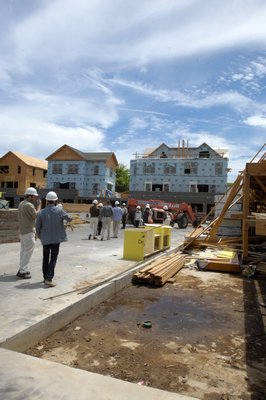
It’s a bird’s-eye view from the rooftop terrace of a $4 million model Watchcase penthouse in Sag Harbor.
From high above the treetops, the views sweep across Sag Harbor Bay, brush the top of the Variety Store on Main Street and, to the west, halt at the unmistakable tower of white that is the Old Whalers’ Church.
It is the village, in panorama, as seen from the first of 64 luxury homes to be completed in the ongoing renovation and retrofit of the 1881 Bulova Watchcase factory. Construction, which begin in 2011, is—despite outside appearances—roughly halfway done, homes in the former factory building are about 43 percent sold out, and residents are expected to begin moving in next spring, according to its developers, Cape Advisors.
The units include multimillion-dollar factory lofts, and factory loft penthouses, as well as townhouses and bungalows, which are not a part of the former factory building, but are being designed to fit in with Sag Harbor’s “eclectic, historic residential neighborhoods.”
“All these years it was an object of curiosity for so many people. It’s exciting to see it come to life again as sort of a second act,” said Curtis Bashaw, a partner for Cape Advisors, during a hardhat media tour last Thursday, June 6. “It’s kind of a collector’s item. There’s not anything like it anywhere. It’s a once-in-a-lifetime opportunity for someone to live in something like this so close to Main Street.”
Indeed, Watchcase’s uniqueness is its shining glory and a huge source of pride for Cape Advisors and its team, which includes the design firms Baldassano Architecture and Beyer Blinder Belle Architects, builder Racanelli Construction and interior designer Steven Gambrel.
The old factory, a hulking, crumbling “eyesore” in central Sag Harbor for years after its closure in 1981, is gradually turning into a deluxe condominium complex in a community composed largely of single-family houses.
At the model two-bedroom penthouse last week, a private rooftop garden and fire pit adorned the terrace. Inside, the commodious unit featured giant windows—a key feature for workers making gold and precious metal watchcases. Cape Advisors raves about the light.
“What better thing can you imagine for people to live in with windows like this? [It’s] unheard of—even in New York,” said Jack Beyer, a partner for Beyer Blinder Belle, which also restored Grand Central Terminal in Manhattan and the Ellis Island Immigration Museum. “That’s one of the greatest things about this building.”
Other highlights include the repurposing of more than 20,000 original bricks in the factory building; the exposed original southern yellow pine timber beams and plank ceilings of the factory lofts; preserved, original features like unusual fan beams; and the raised floors that conceal mechanical systems. The beams were blasted with 80,000 pounds of walnut shells to remove the paint in a more environmentally friendly and less destructive way than normal sandblasting, said Craig Wood, a chief executive for Cape Advisors. The factory’s original octagon at the corner of Washington and Division streets is being rebuilt to its full five-story height.
There are other special touches, too. A granite vault once hauled to the site on ship in the 19th century, and used at the factory to make precious metals, is slated to be integrated into a kitchen for one of the units, Mr. Wood said, ducking as he stepped into the vault last week.
The old water tower is being restored with a “replica wood water tank” that Cape Advisors says is “reconceptualized as a charming outdoor gazebo.”
“You really have all of these unique floor plans,” Mr. Wood said. “We could have gone and done some cookie-cutter thing that went up and down, but you would miss so many of these little elements.”
Although there are many environmental features, Cape Advisors opted not to pursue Leadership in Energy and Environmental Design, or LEED, status, because of the administrative burden that the designation posed, said Arthur Blee, the director of design and construction for Cape Advisors.
The southern part of the site has been excavated to create an underground parking garage, which will be topped with a garden courtyard, fitness center and swimming pool.
The idea is not to be a gated, walled-off community, Mr. Wood pointed out. The public will be welcome inside, but, no, he said when asked, they may not use the pool.